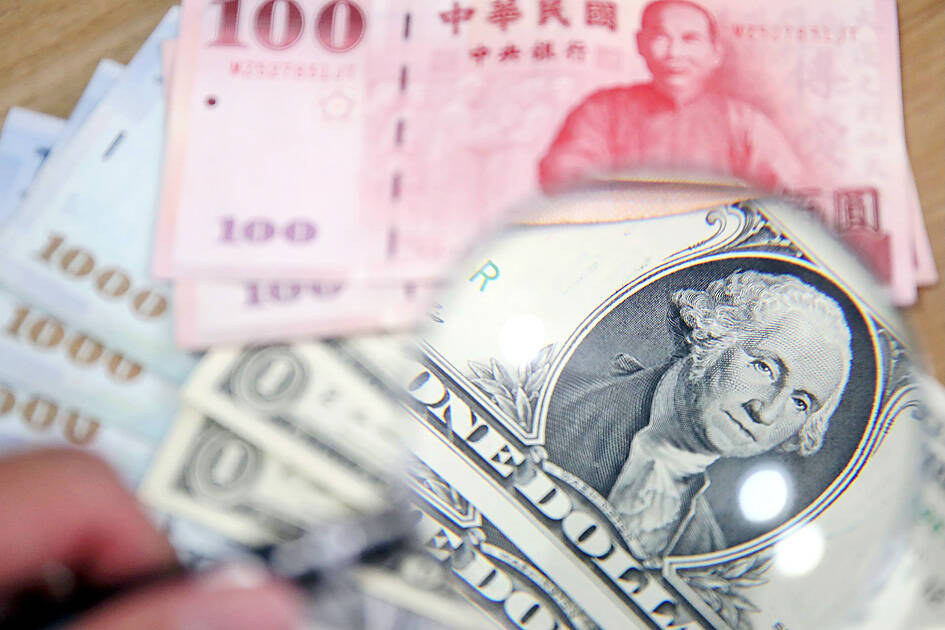The worst could be over for the New Taiwan dollar as China’s economic recovery and a rebound in the chip industry will support the beleaguered currency, analysts said.
The NT dollar is on course to weaken for a sixth month, the longest stretch since 2006, after foreign funds turned sour on its technology sector and risk sentiment deteriorated on slower growth in China.
The tide seems to be turning now on nascent signs of stabilization in China’s economy — its biggest trading partner — following policy boosts. The yuan emerged as the best-performing Asian currency last week, followed by the Japanese yen and the NT dollar.

Photo: CNA
The outlook for semiconductors might also provide tailwinds to the currency as Taiwan is home to the world’s biggest chipmaker, Taiwan Semiconductor Manufacturing Co (台積電).
“Improved China economic prospects and a turnaround in the chip cycle should be positive for the [New] Taiwan dollar,” said Eddie Cheung (張敬勤), senior emerging markets strategist at Credit Agricole CIB in Hong Kong. “The capping of the yuan and the pullback in the [US] dollar should act to restrain [New] Taiwan dollar weakness in the near term.”
He estimates the NT dollar would strengthen toward NT$31.1 per US dollar by December. It dropped to a 10-month low this month before paring losses to close at NT$31.978 yesterday.
Foreign inflows returned to Taiwanese stocks last week following stimulus measures in China, which accounts for about a quarter of its total trade. Blockbuster earnings from US chipmaker Nvidia Corp have also sparked hopes of a boom in the tech sector, and Taiwan being the world’s largest chip exporter could benefit from it.
Yet risks remain due to some skepticism over the chip industry’s rebound and geopolitical factors, with Taiwan warning that China is ratcheting up its military pressure.
Investors will now be focused on the nation’s central bank rate decision on Thursday for any cues on the interest-rate path and further support for the local currency.
Technically, the NT dollar has support at its low for last year of NT$32.345 to help stem its decline. Bank of America Corp does not see it breaching that level and predicts the currency would end the year at NT$31.7 versus the US dollar.
“This forecast is largely a combination of moderating [US] dollar strength as we approach the end of the Fed-hiking cycle and our expectation of more meaningful fiscal response by the mainland Chinese authorities to counter the trend of weakening growth,” Bank of America strategist Cheung Chun Him (張駿謙) said.

The US dollar was trading at NT$29.7 at 10am today on the Taipei Foreign Exchange, as the New Taiwan dollar gained NT$1.364 from the previous close last week. The NT dollar continued to rise today, after surging 3.07 percent on Friday. After opening at NT$30.91, the NT dollar gained more than NT$1 in just 15 minutes, briefly passing the NT$30 mark. Before the US Department of the Treasury's semi-annual currency report came out, expectations that the NT dollar would keep rising were already building. The NT dollar on Friday closed at NT$31.064, up by NT$0.953 — a 3.07 percent single-day gain. Today,

‘SHORT TERM’: The local currency would likely remain strong in the near term, driven by anticipated US trade pressure, capital inflows and expectations of a US Fed rate cut The US dollar is expected to fall below NT$30 in the near term, as traders anticipate increased pressure from Washington for Taiwan to allow the New Taiwan dollar to appreciate, Cathay United Bank (國泰世華銀行) chief economist Lin Chi-chao (林啟超) said. Following a sharp drop in the greenback against the NT dollar on Friday, Lin told the Central News Agency that the local currency is likely to remain strong in the short term, driven in part by market psychology surrounding anticipated US policy pressure. On Friday, the US dollar fell NT$0.953, or 3.07 percent, closing at NT$31.064 — its lowest level since Jan.

The New Taiwan dollar and Taiwanese stocks surged on signs that trade tensions between the world’s top two economies might start easing and as US tech earnings boosted the outlook of the nation’s semiconductor exports. The NT dollar strengthened as much as 3.8 percent versus the US dollar to 30.815, the biggest intraday gain since January 2011, closing at NT$31.064. The benchmark TAIEX jumped 2.73 percent to outperform the region’s equity gauges. Outlook for global trade improved after China said it is assessing possible trade talks with the US, providing a boost for the nation’s currency and shares. As the NT dollar

The Financial Supervisory Commission (FSC) yesterday met with some of the nation’s largest insurance companies as a skyrocketing New Taiwan dollar piles pressure on their hundreds of billions of dollars in US bond investments. The commission has asked some life insurance firms, among the biggest Asian holders of US debt, to discuss how the rapidly strengthening NT dollar has impacted their operations, people familiar with the matter said. The meeting took place as the NT dollar jumped as much as 5 percent yesterday, its biggest intraday gain in more than three decades. The local currency surged as exporters rushed to